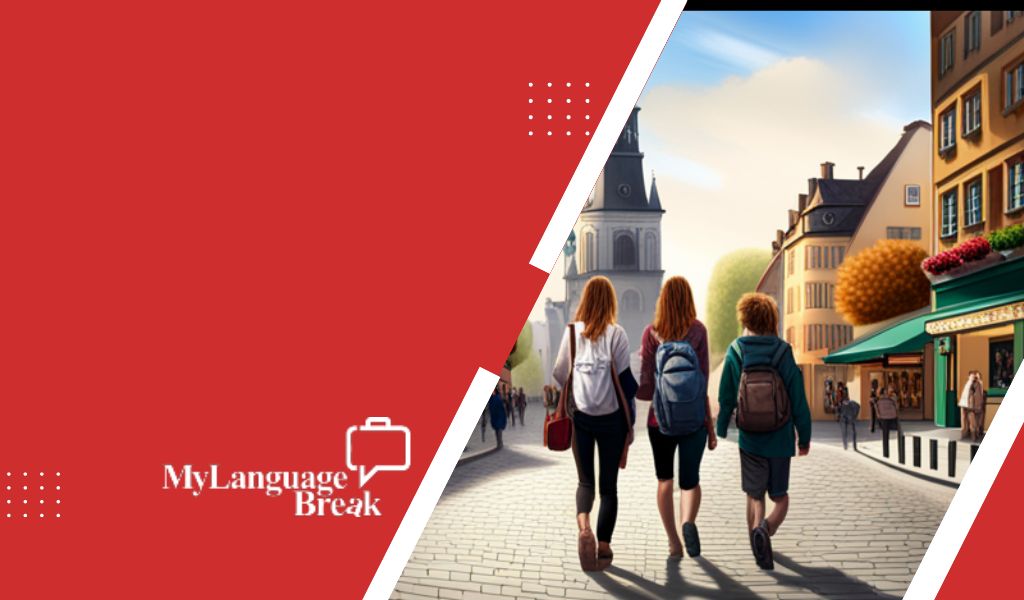Embark on your journey to master German reading comprehension. As a beginner, understanding texts in the German language can be demanding yet critical. Explore strategies from starting with simple A1-level texts to tackling B1 and beyond, enhancing vocabulary, and diving into short stories for easy German reading.
Embarking on the journey of learning a new language is always exciting. For those taking on German, improving reading comprehension is a crucial step.
This article is a guide for beginners, designed to help you navigate through German texts effectively.
We will explore everything from starting with simple A1-level texts to advancing to more complex levels, enhancing your vocabulary, and even using short stories and newspapers to make learning more engaging and relevant. With the right approach and tools, you’ll be able to understand every word, sentence, and passage, enriching your German language learning experience.

Importance of Reading Comprehension in Learning German
Reading comprehension is vital in learning any language, and German is no exception. It forms the backbone of understanding and absorbing new information, aiding in vocabulary expansion, and enhancing overall language proficiency.
Firstly, reading comprehension boosts vocabulary. When you read German texts, you encounter a variety of words – some familiar, others new.
This exposure helps to enrich your vocabulary, providing you with a wider range of expressions to use in conversation.
it provides contextual understanding.
Reading helps you to understand how words and phrases are used in different contexts. This understanding is crucial in grasping the nuances of the German language, which can often be lost in direct translation.
Reading comprehension improves grammatical understanding.
German grammar can be complex, with its der, die, das articles and four noun case system. Regular reading helps familiarize learners with these structures, making them easier to understand and use accurately.
Reading comprehension is a powerful tool that amplifies cultural understanding.
When you dive into German literature, news articles, or blogs, you unlock fascinating insights into German culture, history, and societal norms.
Trust me, this cultural knowledge adds a whole new level of excitement and fulfillment to your language learning journey. So, why wait? Let’s embark on this enriching adventure together! 🌟
Mastering reading comprehension is an absolute must for learning German. Not only does it boost vocabulary and grammar, but it also nurtures a profound grasp of the language and culture. Trust me, it’s an invaluable skill! 📚
Starting with A1 Level Texts
Starting your German language journey with A1-level texts is a smart strategy. These beginner-friendly resources are designed to introduce you to basic vocabulary, simple sentence structures, and fundamental grammar rules, setting a solid foundation for further learning.
A1-level texts often revolve around everyday topics like introductions, family, shopping, or hobbies. They use simple sentences, making them easy to understand and digest for beginners. These texts also introduce learners to high-frequency words, which are crucial for basic communication in German.
Grammar is another essential aspect of language learning, and A1 texts provide an excellent introduction. You will start to familiarize yourself with the German case system, verb conjugation, and article usage. This foundational knowledge will be invaluable as you progress to more advanced levels.
Reading A1 texts also helps improve pronunciation.
By reading aloud, you can practice the unique sounds of the German language, enhancing your speaking skills.
Lastly, A1 texts offer cultural insights. From typical German greetings to popular dishes, these texts provide a glimpse into German culture and lifestyle.
In conclusion, starting with A1-level texts is an effective way to kickstart your German learning journey. They provide a balanced mix of vocabulary, grammar, pronunciation, and cultural learning, setting you up for success in mastering the German language.
Advancing to A2 Level Texts
Advancing to A2 level texts signifies an important milestone in your German language learning journey. It marks the transition from absolute beginner to elementary proficiency, where you start engaging with more complex ideas and vocabulary.
A2 level texts delve into a wider array of topics compared to A1 level. They cover areas like travel, work, and health, providing you with a broader vocabulary base. This expanded lexicon allows you to express more complex thoughts and engage in longer conversations in German.
Grammar at the A2 level becomes more intricate. You’ll start to encounter past tenses, modal verbs, and the beginnings of compound sentence structures. Reading A2 texts regularly helps in understanding and applying these grammatical structures correctly.
Reading comprehension at this level requires you to understand the main ideas and pick out specific details in texts. This skill is crucial for everyday communication in German, whether it’s reading a menu or following directions.
Lastly, A2 texts offer deeper insights into German culture and society. They provide glimpses into German lifestyle, traditions, and customs, enriching your language learning experience.
In conclusion, advancing to A2-level texts is an essential step in your German language learning journey. It broadens your vocabulary, deepens your grammatical understanding, and enhances your cultural knowledge.
Tackling B1 Level Texts & Beyond
Starting with B1 level texts and progressing beyond marks a crucial stage in your German learning journey. At this intermediate level, you’re set to explore more complex elements of the language, delve into varied topics, and gain a deeper understanding of German culture.
B1 texts present more advanced vocabulary and complex sentence structures than beginner levels. They cover a wide range of topics, from politics and environment to arts and technology. This broad exposure not only enhances your vocabulary but also helps you engage in diverse conversations in German.
Grammar at this level becomes more intricate. You’ll encounter more compound and complex sentences, reflexive verbs, and subjunctive moods. Regular reading of B1 texts aids in understanding and applying these grammatical aspects correctly.
Reading comprehension plays a significant role at this stage. B1 texts require you to infer meaning, understand implicit information, and identify the writer’s opinion. These skills are essential for effective communication in German.
Lastly, B1 texts offer deeper cultural insights. By exploring contemporary issues, literature, and history through these texts, you’ll gain a profound understanding of German society.
In conclusion, starting with B1-level texts and beyond is a challenging yet rewarding step. It accelerates your language learning, equips you with comprehensive communication skills, and deepens your cultural understanding.
Improving Comprehension through Vocabulary Building
Enhancing reading comprehension through vocabulary building is a proven strategy that significantly improves language proficiency. Various studies highlight the fundamental role vocabulary plays in understanding written text (Pfanz, Tomi). In fact, it is responsible for 70% of reading comprehension problems in elementary schools (Spellingcity.com).
Building a robust vocabulary is key to reading comprehension. Readers cannot fully grasp what they are reading without understanding the words that make up the text (Readingrockets.org). Spelling is a useful tool that can enhance automatic word recognition, thereby boosting reading comprehension (Spellquiz.com).
Teachers can incorporate vocabulary into read-aloud sessions by identifying target words for instruction. Teaching academic vocabulary in-depth using multiple modalities like writing, speaking, and listening is also effective.
For English learners, there’s a close relationship between vocabulary acquisition and reading comprehension. Techniques to build vocabulary usage, comprehension, and structure can significantly improve reading proficiency.
In conclusion, improving comprehension through vocabulary building is an essential aspect of language learning. It enhances understanding of the text and facilitates effective communication.

Enhancing German Reading Practice
Enhancing your German reading practice is a crucial step in achieving language proficiency. By integrating some effective strategies into your learning process, you can significantly improve your understanding and fluency.
Firstly, select appropriate materials. Start with simpler texts such as children’s books or short news articles, then gradually progress to more complex literature. This gradual approach will help build your vocabulary and comprehension skills without overwhelming you.
Secondly, make vocabulary building a priority. Encountering new words is a given when reading in German. Make a habit of noting these words, looking up their meanings, and using them in sentences. This will not only expand your vocabulary but also deepen your understanding of the language.
Thirdly, consider reading aloud. This practice enhances pronunciation and intonation while also improving reading comprehension. It allows you to hear the language, making it easier to remember new words and phrases.
Fourthly, try to infer meaning from context. If you come across an unfamiliar word, try to understand its meaning from the surrounding text before reaching for a dictionary.
Lastly, incorporate regular reading into your daily routine. Consistent practice is key to mastering any language.
Implementing Reading Strategies
Implementing effective reading strategies is paramount to successful comprehension and learning. These techniques not only enhance understanding but also promote active engagement with the text.
Firstly, previewing is a powerful strategy. It involves looking over the text before reading it. Check the title, headings, subheadings, and any accompanying images or graphs. This gives you an idea of what to expect and primes your mind for the information to come.
Next, questioning is a proactive approach. Ask yourself questions about the text’s content, purpose, and possible implications. This encourages critical thinking and deepens your understanding.
Summarizing is another useful strategy. After reading a section, try to summarize it in your own words. This tests your understanding and helps consolidate the information in your memory.
Annotating is a hands-on strategy that involves making notes directly on the text. Highlight key points, jot down thoughts, or underline unfamiliar words. This active engagement aids comprehension and recall.
Diving into Short Stories for Simple German Learning
Diving into short stories can significantly simplify your German learning process. These captivating, bite-sized narratives are not only engaging but also packed with language-learning benefits.
Firstly, short stories are a rich source of vocabulary. They introduce new words and phrases in a context that reflects their actual usage, which aids in understanding and remembering them. Challenging words or idioms become easier to grasp when seen in a story setting rather than isolated in a vocabulary list.
Secondly, they offer exposure to diverse grammar structures. As you navigate through different tenses, sentence constructions, and expressions used in the story, your grammatical prowess is honed naturally and effectively.
Moreover, short stories provide cultural insights. They often depict scenarios, traditions, or viewpoints typical to German-speaking societies, offering you a deeper cultural understanding along with language proficiency.
To maximize the benefits, adopt an active reading approach. Highlight unfamiliar words, make educated guesses about their meanings from the context before checking in a dictionary, and summarize or retell the story in your own words to reinforce comprehension and recall.
Utilizing Newspapers for Real-world Context
Utilizing Newspapers for Real-world Context
Finally, don’t underestimate the power of newspapers for providing real-world context to your learning. Reading newspapers like Die Zeit or Der Spiegel can improve your reading skills and keep you informed about current events in the German-speaking world.
| Level | Types of Texts | Tips |
|---|---|---|
| A1 | Children’s books, basic online articles, flashcards | Start with simple sentences and basic vocabulary |
| A2 | Intermediate online articles, simple short stories | Begin to engage with slightly more complex sentences and vocabulary |
| B1 & Beyond | Complex articles, novels, films | Engage with complex sentences, advanced vocabulary, and cultural nuances |
Conclusion
From starting with simple A1-level texts to tackling B1-level texts and beyond, the guide provides practical strategies to help beginners navigate through German texts effectively.
Improving vocabulary, diving into short stories for easy German reading, and utilizing newspapers for real-world context are all key components of this guide. As Storylearning suggests, these practices can substantially improve your reading comprehension and language skills.
Books like “German Reading Comprehension Texts: Beginners” found on Barnes & Noble, Goodreads, and Walmart are excellent resources that offer engaging texts and helpful strategies for language learners.
Furthermore, websites such as Sloeful and Fluentu provide free materials and fundamental steps to learning how to read German.
The journey of learning a new language is exciting and with the right approach and tools, you’ll enhance your German reading comprehension in no time. Happy reading!

